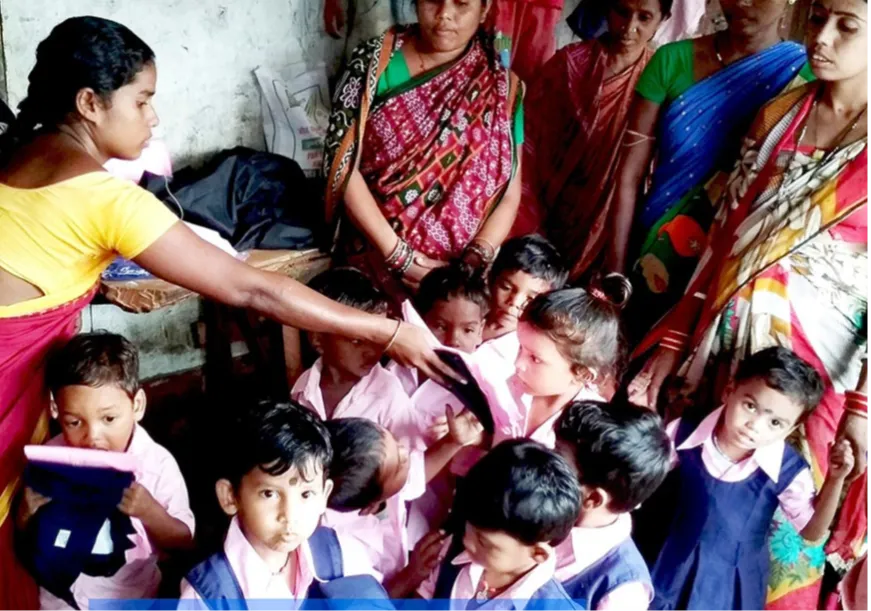-
CENTRES
Progammes & Centres
Location
Increasing public spending on early childhood care and education and empowering India’s Anganwadis is important to ensure that quality early education is accessible to all children

This essay is part of the series “Reimaging Education | International Day of Education 2024”.
Pre-primary education i.e. education for children aged between 3 to 6 years, provides a sound basis for learning in later stages of life. The early years are critical in a child’s development because children acquire language, basic numeracy, motor, and social skills during this period. Most research suggests that the optimal period for oral language development and numbers is in the first three years of life while social skills are developed during 3 to 5 years of life. Therefore, the education system should use these “windows of opportunity” in development to ensure that children get adequate support in learning during this critical phase of life. The India Early Childhood Education Impact Study 2017 also finds that children who have access to quality early childhood education are more likely to have higher learning outcomes in primary grades. Target 4.2 of Sustainable Development Goal (SDG) 4 (inclusive education for all) also calls for the promotion of inclusive and equitable development and learning opportunities for all children in the 3-6 age group.
The education system should use these “windows of opportunity” in development to ensure that children get adequate support in learning during this critical phase of life.
Despite its importance, early childhood education has received policy attention in India only recently. The first policy intervention was made with the adoption of the National Early Childhood Care and Education Policy in 2013. The National Education Policy 2020 emphasises play-based learning methodologies in an inclusive learning environment for children. It mentions four models of early childhood education viz. Anganwadi centres in communities, Anganwadi centres within schools, pre-primary sections within schools, and standalone pre-schools.
For little children, pre-primary education is often their first foray into society away from home and their parents and caregivers. They encounter several challenges like anxiety due to separation from parents or caregivers, problems in socialising with the teacher and other children, stresses of toilet-training, problems in expressing their needs to the teacher, being scared of new teachers and caregivers in school, and problems in carrying out the tasks and activities expected out of them in pre-school. Therefore, pre-primary educational programmes for such small children should be sensitive and mindful of their special needs.
India’s National Early Childhood Education (ECCE) Curriculum Framework acknowledges these challenges and underscores the role of parents, family, and the community in the growth of the child and calls for an informal, play-based learning environment. Further, it stresses the importance of early education in the mother tongue or home language and multilingual classrooms as given the linguistic diversity of India, children in any class could be from different backgrounds and have many mother tongues/home languages.
India’s National Early Childhood Education (ECCE) Curriculum Framework acknowledges these challenges and underscores the role of parents, family, and the community in the growth of the child and calls for an informal, play-based learning environment.
However, in practice, this is rather difficult to achieve. Particularly so, for India’s large urban migrant population which often lives in poverty and struggles to access most government schemes and resources in big cities. Children from migrant families have inadequate access to quality pre-primary education across the globe, not just in India. This is due to several factors such as a lack of knowledge about the importance of early childhood education, limited awareness of early childhood education options in the locality, discrimination from teachers or community workers, and the language barrier. For instance, the families which migrate from the northern states of Bihar or Uttar Pradesh for work are likely to face difficulties in accessing pre-primary education in cities where the medium of instruction is in other languages like Marathi, Malayalam, or Tamil.
The National Early Childhood Education Curriculum Framework recognises this problem adequately and stresses multilingual classrooms. The curriculum framework also suggests that the teachers should try to learn a few words and phrases from the child’s home language and encourage children to express themselves in their own language and also learn from one another. While this kind of learning atmosphere through free play and interaction is ideal, it is important to recognise the practical difficulties. Are most Anganwadi centres responsible for early childhood care and education adequately staffed and the anganwadi workers adequately trained? Are the Anganwadi teachers/caregivers in a position to cope with different languages? Are they receiving the requisite resources, training, and support to be able to care for very small children who are traumatised by separation anxiety and unable to communicate their needs? Are the pre-primary teachers/caregivers trained to be mindful of the child’s social and cultural practices? What about children with special needs? The answers to most of these questions are not in the affirmative. However, these are questions which we will need to grapple with in our quest to provide inclusive and equitable learning opportunities for children in their early years.
The curriculum framework also suggests that the teachers should try to learn a few words and phrases from the child’s home language and encourage children to express themselves in their own language and also learn from one another.
While India’s recent policy attention to pre-primary education is a welcome step, this needs to be backed up by careful thought and real investments, particularly in human resources. One of the biggest barriers to quality early childhood education in India is the lack of trained teachers. Taking care of small children is often not regarded as a job which requires proper training and pre-primary teachers are often poorly paid even in private pre-schools which charge a hefty fee from affluent parents.
A child’s early years have a deep impact on his/her physical, social, and emotional development. For children from disadvantaged or marginalised backgrounds, quality early childhood care and education can play an important role in bridging gaps and improving their life chances. Moreover, quality early childhood education does not only lead to better school readiness and higher academic achievement in primary grades but also has other socio-economic benefits. For instance, it allows the participation of mothers in the workforce and frees up older children, particularly girls, from childcare, which in turn reduces dropout rates at higher grades. Therefore, there are merits in increasing public spending on early childhood care and education and empowering India’s Anganwadis. But more importantly, efforts in this direction must be extremely cautious, sensitive, and mindful of the unique needs of small children. In a nutshell, well begun but a long way to go.
Malancha Chakrabarty is a Senior Fellow and Deputy Director (Research) at the Observer Research Foundation
The views expressed above belong to the author(s). ORF research and analyses now available on Telegram! Click here to access our curated content — blogs, longforms and interviews.

Dr Malancha Chakrabarty is Senior Fellow and Deputy Director (Research) at the Observer Research Foundation where she coordinates the research centre Centre for New Economic ...
Read More +